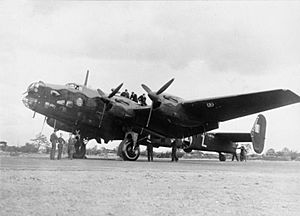No. 76 Squadron RAF facts for kids
Quick facts for kids No. 76 Squadron RAF |
|
|---|---|
| Active | 15 September 1916 – 1 April 1918 (RFC) 1 April 1918 – 13 June 1919 (RAF) 12 April 1937 – 8 April 1940 30 April 1940 – 2 May 1940 1 May 1941 – 1 September 1946 9 December 1953 – 30 December 1960 1 May 2007 – 20 May 2011 |
| Country | |
| Branch | |
| Motto(s) | Resolute |
| Commanders | |
| Notable commanders |
Wing Commander Leonard Cheshire |
| Insignia | |
| Squadron Badge heraldry | In front of a rose, a lion passant, guardant. |
| Squadron Codes | NM (Oct 1938 – Apr 1939) MP (May 1941 – Sep 1946) |
No. 76 Squadron was a special group of planes and pilots in the Royal Air Force (RAF). It was first formed during World War I to protect the home country. Later, in World War II, it became a bomber squadron, flying missions to attack enemy targets.
After the war, the squadron changed roles to transport planes. In the 1950s, it flew bombers again. From 2007 to 2011, No. 76 Squadron was a training unit. It helped new pilots learn to fly the Short Tucano plane at RAF Linton-on-Ouse.
Contents
History of No. 76 Squadron
Forming During World War I
No. 76 Squadron was first created on 15 September 1916. It was part of the Royal Flying Corps (RFC) and was based in Yorkshire, England. Its main job was to defend the country from air attacks.
The squadron used planes like the Royal Aircraft Factory B.E.2 and Royal Aircraft Factory B.E.12. Later, they got Bristol F.2B planes. This first version of the squadron was closed down on 13 June 1919. It did not see any combat during this time.
Serving in World War II
Early Bombers: Wellesleys, Hampdens, and Ansons
No. 76 Squadron was started again on 12 April 1937 at RAF Finningley. It began with Vickers Wellesley bomber planes. By April 1939, they were flying Handley Page Hampdens and Avro Ansons.
When World War II began, the squadron moved to RAF Upper Heyford. Here, it became a training unit. It helped teach new pilots how to fly and operate these planes. On 8 April 1940, it joined with another squadron to form a larger training unit.
Flying the Mighty Halifaxes
The squadron was briefly reformed in April 1940 but then closed again. On 1 May 1941, No. 76 Squadron truly reformed at RAF Linton-on-Ouse. It became the second squadron to fly the powerful Handley Page Halifax bomber.
This squadron was part of No. 4 Group in RAF Bomber Command. They moved to different bases, including RAF Middleton St. George and RAF Holme-on-Spalding Moor. Many pilots and crew members from Norway also served in this squadron. From August 1942 to April 1943, a famous pilot named Leonard Cheshire led No. 76 Squadron.
Transporting Goods with Dakotas
In May 1945, after the war ended, No. 76 Squadron changed its role. It joined RAF Transport Command. The squadron started using Douglas Dakota planes. These planes were used to carry supplies and people.
The squadron moved to India in September 1945. It was officially closed down on 1 September 1946 at Palam Airport. Its planes and duties were taken over by another squadron.
Post-War Missions
No. 76 Squadron was reformed again on 9 December 1953. This time, it was based at RAF Wittering and flew English Electric Canberra B.2 bombers. In November 1955, the squadron moved to RAF Weston Zoyland.
Some of their planes were used for a special mission called Operation Grapple. During this operation, from 1956 to 1958, the planes collected air samples. They flew through the clouds created by nuclear tests to gather information. This helped scientists understand more about radioactivity. The planes were specially changed to do this important work.
The squadron was closed down on 30 December 1960 at RAF Upwood.
Training New Pilots
No. 76 Squadron remained inactive for many years. It was brought back on 1 May 2007. It became No. 76 (Reserve) Squadron at RAF Linton-on-Ouse. This time, its job was to train new air navigation officers.
They used Short Tucano T.1 planes for training. In 2008, Prince William even spent three months at Linton learning to fly. No. 76 Squadron continued its training role until December 2010. It was finally closed down in May 2011.
Aircraft Operated by No. 76 Squadron
Over its history, No. 76 Squadron flew many different types of aircraft:
- Royal Aircraft Factory B.E.2c (September 1916 – 1917)
- Royal Aircraft Factory B.E.2e (December 1916 – August 1918)
- Royal Aircraft Factory B.E.12 (September 1916 – August 1918)
- Royal Aircraft Factory B.E.12a (December 1916 – August 1918)
- Airco DH.6 (September 1916 – 1917)
- Royal Aircraft Factory R.E.8 (May 1917 – July 1918)
- Royal Aircraft Factory B.E.12b (March 1918 – August 1918)
- Bristol F.2b (July 1918 – August 1918)
- Avro 504K (August 1918 – May 1919)
- Vickers Wellesley (April 1937 – April 1939)
- Handley Page Hampden Mk.I (March 1939 – April 1940)
- Avro Anson Mk.I (May 1939 – April 1940)
- Handley Page Halifax B.I (May 1941 – March 1942)
- Handley Page Halifax B.II (October 1941 – April 1943)
- Handley Page Halifax B.V (February 1943 – February 1944)
- Handley Page Halifax B.III (January 1944 – April 1945)
- Handley Page Halifax B.VI (March 1945 – May 1945)
- Douglas Dakota Mk.IV (May 1945 – September 1946)
- English Electric Canberra B.2 (December 1953 – December 1955)
- English Electric Canberra B.6 (December 1955 – December 1960)
- Short Tucano T.1 (May 2007 – May 2011)


